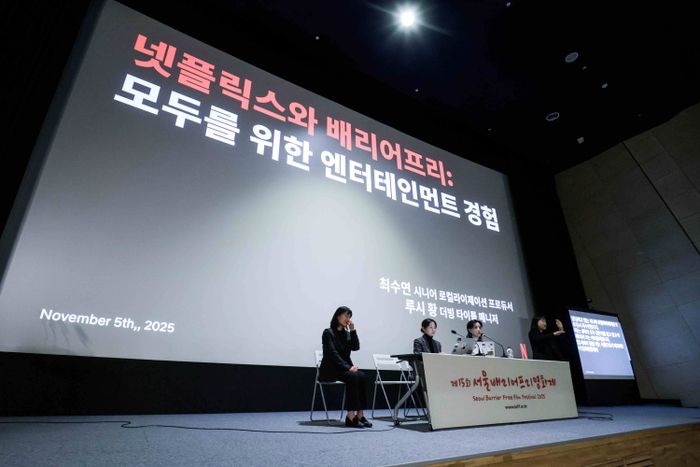
Netflix announced on Thursday its participation in the 15th Seoul Barrier Free Film Festival’s Barrier Free Forum, hosted by the Korea Barrier Free Film Committee on Wednesday.
Celebrating its 15th anniversary, the Seoul Barrier Free Film Festival continues to champion accessibility in cinema, ensuring that films can be experienced by everyone, regardless of physical ability.
Held at the Korean Film Archive, the forum reflected on 15 years of progress while exploring the future of barrier free film culture through domestic and international case studies.
The panel featured Netflix representatives alongside Tatsuhito Utagawa, director and head of Japan’s Film Project, and Chihoko Hiratsuka from the universal cinema Cinema Chupki Tabata. Together, they discussed ways to advance inclusive film experiences.
Invited for its ongoing leadership in accessibility innovation, Netflix has worked closely with the Korea Barrier Free Film Committee since its Korean launch in 2016, when it introduced audio description services.
Collaborations have included barrier free screenings such as Jung_E (2023) and recent accessibility case studies.
Kim Soo Jung, head of the Korea Barrier Free Film Committee, explained that Netflix was chosen to highlight its role in transforming accessibility from a welfare consideration into a cultural and industrial value. She commended the platform for reimagining inclusive viewing as a universal right.
Representing Netflix, Choi Soo Yeon, senior localization producer, and Lucy Huang, dubbing title manager, detailed the company’s global barrier free initiatives. Netflix currently offers subtitles for the hearing impaired in up to 62 languages and audio descriptions in up to 17 languages, supported by over 150 dubbing and 68 audio description partners worldwide.
To date, Netflix has provided around 30,000 hours of audio description content and, between January and August 2024, produced nearly 30,000 hours of Korean subtitles for the hearing impaired. Nearly half of Netflix’s total global viewing time now includes subtitles, regardless of audience disability status.
The company also integrates feedback from deaf and hard of hearing communities through surveys and focus groups, shaping how subtitles and audio descriptions are produced.
Among its latest innovations is the Korean Original Subtitles feature, offering dialogue only text — a format appealing to both disabled and non disabled audiences. Originating in Korea, this feature is now expanding globally.
In audio description, Netflix is exploring genre specific narration and improving studio accessibility for visually impaired professionals.
Recent initiatives include publishing a comprehensive barrier free case study, hosting an inclusive screening of K Pop Demon Hunters for 200 visually and hearing impaired students, and sponsoring accessibility focused media festivals.
A Netflix spokesperson reaffirmed the company’s mission: Netflix remains committed to creating entertainment experiences that allow everyone to share in the same emotional moments together.










